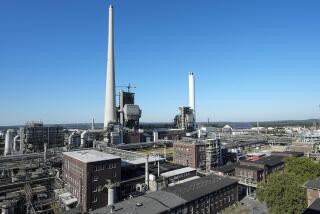Industrial Wasteland Transformed Into a Theme Park of Sorts
- Share via
ESSEN, Germany — Soot-stained windows, derelict cranes and an olfactory sting from lingering coal dust would hardly seem the stuff of civic pride and nostalgia.
But here in Germany’s rust belt, the Ruhr River valley known as the Ruhrgebiet, one person’s reminder of pollution and oppressed labor is another’s monument to those whose sweat and blisters brought about an age of industrial prowess.
The idle wreckage of the Industrial Revolution that litters the depressed Ruhrgebiet has been transformed by a huge urban renewal project into tourist sites and tributes to the region’s steelworkers and miners. In this era of commitment to cultural and historical preservation, there is newfound respect for all that was once condemned as die Poette: the pits.
There’s no place more posh for private parties than the old gas compression workshop of the long-dormant Zollverein mine, where just enough heavy machinery has been left amid the blackened brick walls and overhead catwalks to create an atmosphere of dining adventure.
At Essen’s disused coke plant adjacent to the Zollverein, which 70 years ago was the world’s busiest coal mine, a Ferris wheel now travels the circuit of a former coal conveyor, dipping below ground into the old furnace-stoking chamber to give visitors a glimpse of the bygone life of a laborer.
In nearby Gelsenkirchen, the North Rhine-Westphalia State Mining Museum has restored an idle shaft to working order so tourists can don protective clothing, ride the elevators and coal cars to the depleted seams and walk in the footsteps of the region’s forefathers.
“It’s a tragedy that so much of the Ruhrgebiet has been destroyed, either by war or by those who thought once the industrial use of these sites was over that they had no value,” says Delia Boesch, spokeswoman for the Community Assn. of the Ruhr Valley Region. “This is our architectural and social heritage.”
In the last year, the association--together with the city, state and federal governments--has choreographed the sprucing up and splicing together of a 250-mile Route of Industrial Culture. The road’s 19 anchor sites and dozens of parks and other scenes of interest run the gamut of education and entertainment, from the golf course covering the slag heaps of Oberhausen’s defunct steel plant to the paintings gracing the walls inside the towers and tanks in an old gasworks.
The $2.5-billion project that puts a retro spin on urban renewal also has transformed some symbols of the smokestack era into chic condos and office space. At Duisburg, erstwhile grain storage towers are now coveted waterfront housing. Here in Essen, onetime company-owned houses built at the turn of the century have been restored and rented to low-income families.
Even the opulent Villa Huegel--once the home of the Ruhrgebiet’s most notorious steel magnate and ally of Adolf Hitler, Alfred Krupp--has recovered its 19th century splendor to host major art exhibits. The estate is the center of a sprawling public park overlooking Baldeney Lake.
Because so much of the heavy industry in this blue-collar bastion was closed during the last quarter century, the valley suffered one of Germany’s highest unemployment rates until the huge restoration project began creating jobs, says Detlef Feige, spokesman for Essen’s city government. Project organizers estimate that as many as 5,000 new workplaces have emerged along the route.
“There was nothing here but steel, coal and heavy industry, which hindered the growth of services because the big employers provided everything from housing maintenance to insurance,” says Feige, noting that the region is enjoying a relative boom in small private enterprises, such as bed-and-breakfast inns.
Miners made redundant as many as 20 years ago have been brought back as museum guides and tour directors for underground visits, and the long-ignored expertise of retired blast furnace tenders and machine builders is being tapped in the development and display of the region’s industrial history.
Along the well-marked industrial culture route, visitors can absorb the region’s rough-skinned history at museums dedicated to waterworks, railroad construction, energy production and welding, as well as by glimpses of disappearing industrial skills available at the ubiquitous mines and steelworks. Those unable to make the journey can virtually visit the Ruhrgebiet (https://www.route-industriekultur.de) through the project’s Web site.
More than 80% of the funding for restoring the sites was provided by grants from the European Union, which is seeking to create a model for structural change on a continent beset with declining industrial zones as services and high-tech enterprises increasingly dominate the economy. But the route eventually will have to pay its own way through fund-raising and fees charged for catering and entertainment, says C. Marie Mense of the Zollverein Foundation, which manages the part-public, part-private mine complex that offers everything from a gourmet restaurant to leased office space.
The route was established in May and proved astoundingly popular as a tourist attraction in its inaugural summer, with more than 220,000 visitors to the coke plant’s art museum in five months, curator Annette Kolkau says. She is busy preparing for the cavernous facility’s second season.
“Most cities are known for the church steeples that distinguish their horizons,” says Kolkau, as she gazes out at Essen’s landmarks of rust and concrete. “But this is our identity, and we find it just as inspiring.”
More to Read
Sign up for The Wild
We’ll help you find the best places to hike, bike and run, as well as the perfect silent spots for meditation and yoga.
You may occasionally receive promotional content from the Los Angeles Times.






